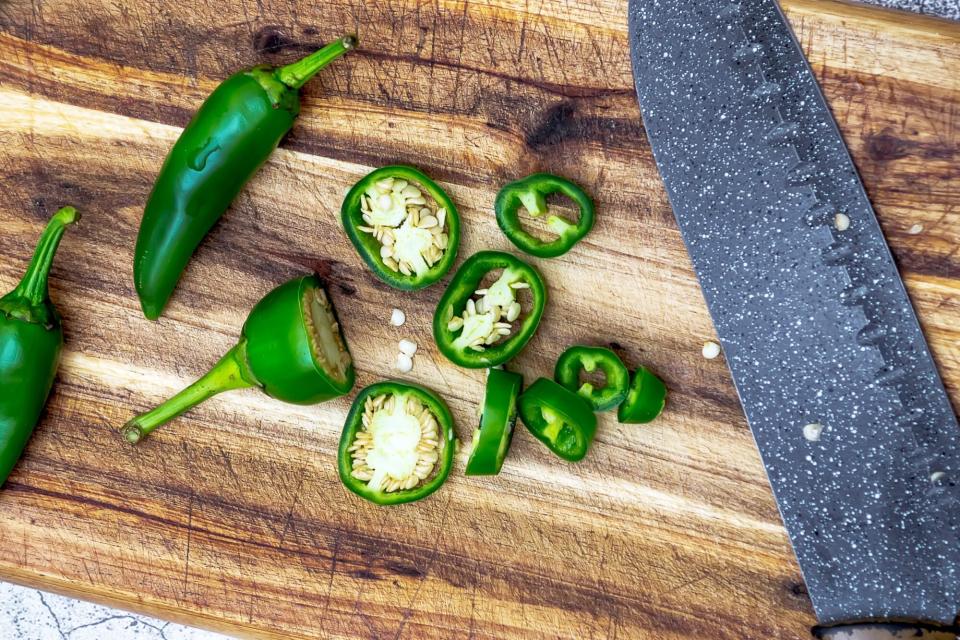Why Does the Oil from Jalapeños and Other Chiles Burn Your Hands? Plus, How to Stop It
If you're a fan of spicy food, you've probably experienced a burning feeling on your hands after cutting a jalapeño or other chile pepper. That uncomfortable tingling is caused by capsaicin, which is the same oil-like substance that gives peppers their delightfully spicy flavor. But why does it burn, exactly? According to Olivia Roszkowski, chef-instructor at the Institute of Culinary Education, capsaicin binds to receptors on your skin, creating a nervous system response that's similar to the feeling of being exposed to high temperatures. The result is a burning sensation, which can be downright uncomfortable and inconvenient.
Related: Check Out Our Chile Pepper Glossary

Yancho Zapryanov / 500px / Getty Images
How to Remove Chile Oil from Your Hands
If your hands burn after slicing or deseeding chiles, there are a few things you can do to get rid of the capsaicin oil. The good news is that you can remove the sting with nothing more than common household items, so relief is fast. The first technique calls for oil, such as olive oil or coconut oil. "Capsaicin is soluble in fat, so rubbing [your] hands with an oil for 30 seconds then rinsing with soapy water can help remove the sting," says Roszkowski. "This is much more effective than just rinsing with water, which can actually spread the capsaicin to a larger area on your hands."
You can also try neutralizing the capsaicin with something sweet, like honey or molasses. "Sugars can bind to pain receptors in [your] hands more easily than capsaicin, so this can eliminate or minimize the burning sensation," explains Roszkowski. Start by making sure the area is clean and removing excess capsaicin using the rinsing method mentioned above. Next, wear a glove to keep things mess-free, and apply a thick layer of honey or molasses to the area. You could even a fill a kitchen glove with either ingredient to maximize contact with less mess, says Roszkowski. "Because the syrup can trap in heat, it might feel warm at first," notes Roszkowski. However, the method "can offer relief after 10 to 30 minutes," she says. Reapply often and as needed. Whichever remedy you choose, be sure to do it as soon as you feel the burn.
How Long Will the Burning Last?
Generally, a pepper burn will last for a few hours, but without a remedy, some burns can last for more several hours or even days. That said, the exact length of time can vary greatly, as it depends on the type of pepper and actual level of capsaicin, says Roszkowski. Peppers with higher levels of capsaicin are hotter and spicier, so they'll create a longer-lasting burn. For instance, on the Scoville scale, a jalapeño pepper falls between 2,500 to 5,000 Scoville heat units. Meanwhile, Thai peppers are between 50,000 to 100,000. This means the burn from one jalapeño won't last as long as the burn from one Thai pepper.
It's worth noting that the actual capsaicin molecule is the same from pepper to pepper, so your stint of chili hands will also depend on how much capsaicin you're exposed to. For example, working with 20 jalapeños will create a more intense burn than working with one Thai pepper, says Roszkowski. Similarly, if you're creating a highly concentrated recipe, like hot sauce, the burn may be extremely painful and last longer than 24 hours. Ripeness plays a factor, too. "Capsaicin is at its peak for a few weeks after the flower opens on a plant, then decreases slightly as the pepper sits on a grocery shelf for days or weeks," explains Roszkowski. Thus, if you're handling a freshly picked pepper from your garden or farmers' market, you might be exposed to more capsaicin while cutting and de-seeding—and ultimately, a longer burn.
If the sensation is severe or doesn't get better after a few days, see a healthcare professional. Depending on your symptoms, they might recommend treatments like burn cream and/or pain relievers.
How to Prevent Jalapeño Chile Hands
Once you've experienced a chile pepper burn, you likely won't want it to happen again. One of the best ways to avoid it is to wear disposable gloves. If you're handling extra-hot peppers (like Scotch bonnet peppers), wear thicker rubber gloves. You can also prevent the sensation by using the right cutting tools. "Use a sharp knife to cut away some of the pith and seeds, where the capsaicin [is concentrated]," says Roszkowski. If you use a dull knife, you'll be more likely to crush the pith and seeds, ultimately spreading the capsaicin oil on your cutting board and hands.
You can also cut the pepper in half and coat it with an acid, like citrus juice or vinegar, for a few minutes. This can help neutralize some of the capsaicin and reduce your exposure while cutting, notes Roszkowski. When you're done cutting the peppers, wash all your equipment (cutting board, knives, etc.) to prevent spreading the capsaicin to future ingredients or dishes.

